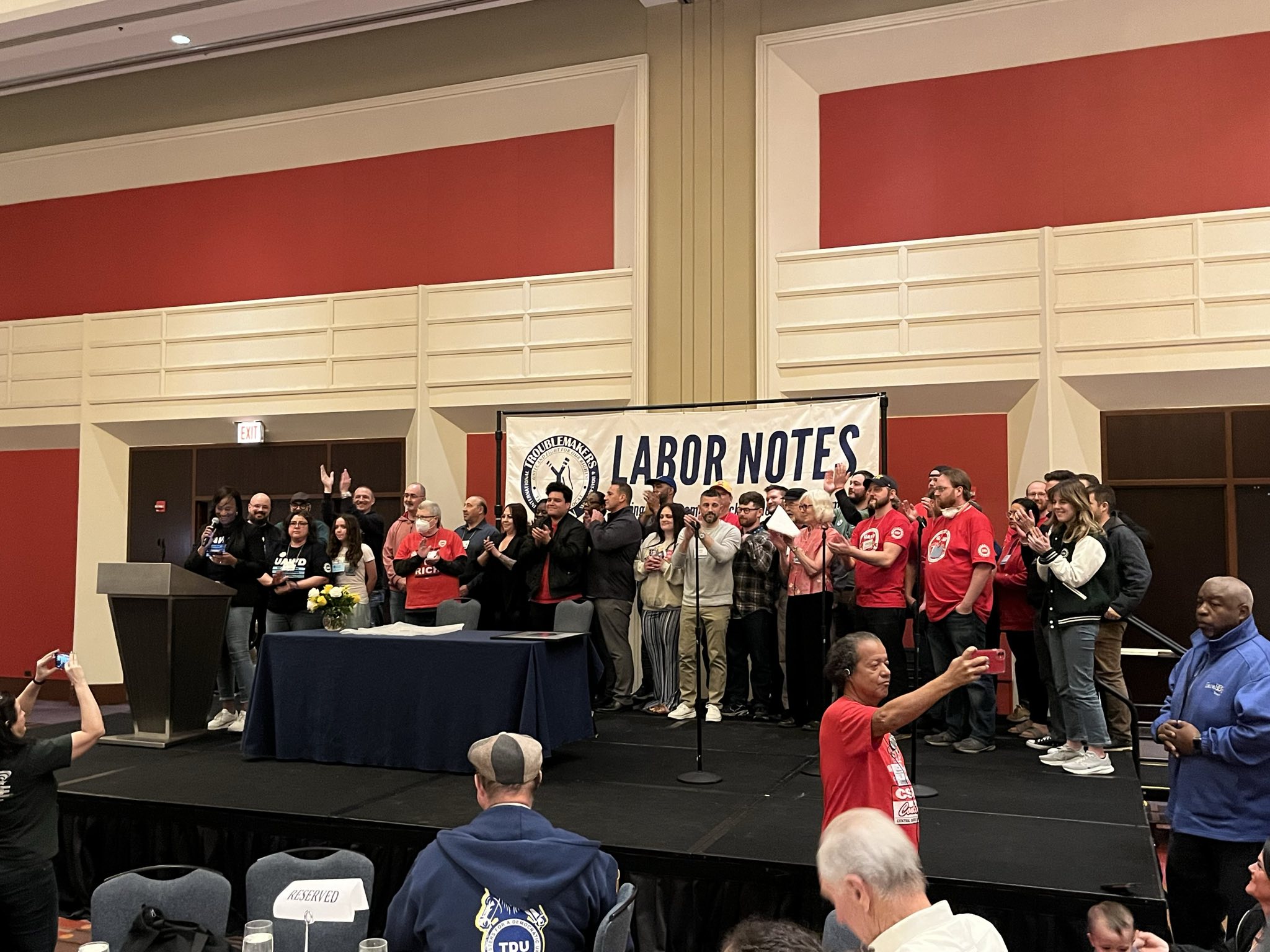Introducing a publication written by Dr. Johannes Schulten and Jörn Boewe, supported by the Rosa Luxemburg Stiftung’s Geneva Office, which asserts the global transformation of the automotive industry. The English translation of the publication will be released soon.
The automotive industry plays a pivotal role in the intersection of climate change, industrial policy and labor struggles. The most essential element of this transformation is electrification. On the one hand, electric cars still make up a comparatively small segment of the global automotive fleet, but the production growth rate is impressive. There is no longer a doubt that the battery-electric drive will displace fossil combustion engines as the most widespread drive concept in the not-so-distant future. At the same time, it is obvious that in some regions of the world internal combustion engine-powered vehicles will remain in use for a long time. For how long and to what extent are open questions. One of the most popular examples of that industry upheaval is Tesla. The company does not have the highest sales worldwide compared to other big car manufacturers, but it’s the largest manufacturer of e-cars worldwide.
In recent years, the company has expanded to the European market, depicting itself as “accelerating the world’s transition to sustainable energy.” When Tesla opened its first European Gigafactory in March 2021, located just across the city limits of Berlin in the state of Brandenburg, the residents initially welcomed it. The region is still dealing with the aftermath of the reunification between West and East Germany that started 1989. Socio-economic inequality still prevails in the region today such as unequal distribution of income or higher unemployment rates. Residents were excited about the prospect of more jobs and a change in the region’s image through a multinational company like Tesla.
There were a few critical voices who feared droughts or contamination of the source water protection area close by. When CEO Elon Musk was interviewed during the factory opening in Brandenburg, he laughed off a question about water concerns. “Look around you. It’s like water everywhere here. Does this seem like a desert to you?” After one year, there have already been several “operational incidents” at the site, including leaked chemicals and burned waste. Stoking the flames of discontent lately was that – contradicting Musk’s previous statement – Tesla started testing the water table level in the area without any permission from the environmental agency, because they are running out of water. On top of that, the complaints of Tesla employees about excessive overtime hours, stressful rotating shifts, and cold factory halls became public.
Meanwhile, the company is actively fighting unionization efforts, both in Germany and the United States. In 2017, at Tesla’s Fremont, California plant, workers led an effort to unionize with the United Auto Workers (UAW). One of the workers gave a devastating statement that working for Tesla feels like “working for a company of the future under working conditions of the past”. When the campaign went public, Musk responded with offensive Twitter posts and waves of layoffs. Musk dissolved the company’s PR department in late 2019, and has refused to make any public statement regarding acts of illegal retaliation against pro-union employees. This year, after employees from the Buffalo, New York plant had launched their union campaign, Tesla fired more than 30 employees.
The automotive industry is collectively facing many challenges and Tesla is at the center of most of them. In March 2023 the Rosa Luxemburg Stiftung – Geneva Office published “Transformation of the Global Automotive Industry,” by Dr. Johannes Schulten and Jörn Boewe. This publication examines the intersections between the transformation of the automotive industry, unionization and the climate crisis. RLS-NYC recently spoke with Dr. Schulten about his study.
The following interview has been translated from German and edited for length and clarity by the author.
First of all, can you briefly introduce your publication in a few sentences: What is the study about, and which methods did you use?
Schulten: For a start, we aspired to make an accessible publication to reach the largest audience possible. We wanted it to sort of stand out from scientific studies and to be less exclusive. Secondly, the aim of the publication was to present the consequences of the framework of “double transformation” that we are considering in the automotive industry, on one hand, the efforts toward decarbonization and on the other hand the digitalization. Thirdly, we conducted our research on a global level. We wanted to discuss fundamentally, what this transformation means on a global scale. We talked to trade unions and scholars worldwide in about 40 qualitative interviews. We took a comparative look at the different regions that are currently important for the automotive industry and which may gain in importance because of the double transformation – Germany, the USA, and Japan.
We have a long chapter on the “future centers” like China, but we have also looked at the so-called peripheries such as Mexico, Eastern Europe, and South America. What are the consequences of the transformation for the value chains in the automotive industry? How do trade unions worldwide are reacting to this challenge? Moreover, I think the very special thing about this study is that we are not writing for a selected academic audience – we always call it “publications for those who are not paid to read.”
What are the particularities of the global automotive industry in comparison to other sectors such as the railway industry, given the debates on climate and structural change as well as trade union organizing?
Schulten: The automotive industry is one of the most important global industries in terms of the number of employees and value creation. In addition, compared to other industries, the sector has achieved the most far-reaching success in fighting for workers’ rights in the past 100 years. It is an industry that has a comparatively high percentage of unionization, at least in regions of Europe, the USA, and to some extent in South America. Therefore, social standards in the global automotive industry are comparatively good and that may function as a role model for other industry sectors. This makes the automotive industry interesting from a trade union point of view alone, or from a left-wing point of view.
That is one thing, but the other is the ecological or climate policy point of view. According to the International Energy Agency, the transport sector is responsible for more or less a quarter of global CO2 emissions. Despite technological improvements in recent years, which there have certainly been in terms of efficiency, CO2 emissions have remained stable. Practically nothing has changed, neither in Germany nor in the United States.
So there we have these two issues, the necessity of trade union strength in this industry and the necessity of an ecological transformation. This tension, this dichotomy between these two urgent aspects of the industry are very interesting.
Which insights or chapters could be particularly interesting for US readers?
Schulten: Of course, there is a chapter explicitly on the United States. I cannot ensure it is interesting to highly specialized people, especially since we could not include the recently passed Inflation Reduction Act (IRA). The IRA is very interesting from a German or European perspective because we can observe a return of a strong state with an active industrial policy. From a trade union perspective, it is definitely a step forward from the model of the lean economy state, which is hegemonic on this side of the Atlantic.
Otherwise, I think for Americans the view from the outside could be interesting too, and that applies to the industrial policy as well as the social-ecological discussion we are having in Germany and its trade unions. Despite all the criticism coming from the German left-wing oriented people towards labor unions like IG Metall*, our research shows that the discussion is actually much more advanced here than in other highly industrialized countries.
We also discuss existing attempts of international relations in trade unions, such as the partnerships between the IG Metall and trade unions in the Eastern European periphery like Romania. Also, in 2015 the IG Metall announced to deepen ties with U.S. union UAW. That makes perfect sense, according to the transnational supply and production chains we have nowadays.
[*Editor’s note: The IG Metall “Industrial Union of Metalworkers'”) is the dominant metalworkers’ union in Germany, making it the country’s largest union as well as Europe’s largest industrial union. They’re mainly representing workers in the metal and electronic industries. Unlike in the US, trade unions remain sector-specific. IG Metall is actively trying to unionize Tesla and therefore plays a pivotal role in this context.]
What are the most important things Americans should know about the IG Metall battle with Elon Musk in Berlin-Brandenburg?
Schulten: People from outside, including me, hardly get any information about internal processes in organizing. Mostly, IG Metall is not willing to discuss their strategy in public. They don’t want to jeopardize any employees and their goals. What one can say, however, is that IG Metall started to invest considerable resources early, both human and financial, in the development of a newly built Tesla plant. They started their work right after the opening of the factory. That was strategically crucial. In the meantime, about 10,000 people work there, so employment has increased enormously in the last few years. It may sound a bit banal at first, that a trade union has recognized they need to act immediately and invest accordingly into resources on site. Yet, if you take a look at the difficulties trade unions have to build up power over years, for example at Amazon or other large companies, how hard it is for them to reallocate resources and to work on a concept – and perhaps in five years, they can somehow achieve success. I believe that it was a remarkable achievement of IG Metall to have reached this point so early. As far as I can tell, workers on site have already joined the union in very high numbers.
Interestingly you mentioned the discretion of Unionizing in Germany with regard to their strategy. It definitely struck me as well how big the willingness is to go public with their campaigns in the US. Employees frequently use Social Media for gaining support and attention. Could you maybe elaborate further on differences between German and US unionizing and what Germany can learn from strategies in the USA and vice versa?
Schulten: First, there are enormous differences in the industry policies in both countries, without getting into details now. In the United States, unions must undergo a recognition process initially. In a voting process, 50 percent of workers must vote in favor of the right for the union to be on-site and to have a right of access to the company, so to speak. In fact, there is a lot of work that is done in secret in the USA, but more in the early stages, so that the employer does not find out that organizing is taking place and countermeasures can be taken.
Once this hurdle is cleared, if I am not mistaken, a union member in the workplace has an immediate right to distribute leaflets, set up membership meetings, and use Social Media for their purposes. This is a huge hurdle, which does not exist in Germany. This explains a whole series of differences of organizing.
In Germany, you have an immediate right to form a “works council”, like a company-level body of representatives. It’s a legal instrument guaranteed by the government to negotiate fairer working conditions together with a trade union. This is an essential tool for the improvement of working conditions, but it also means being tied to formalities to a certain extent like being less self-determined, also in terms of public presentation.
Interestingly at the Gigafactory Berlin-Brandenburg, Tesla has been strategically very clever and established a works council on its own initiative at the beginning. They probably learned from the fights in Amazon in Germany, which initially was fighting their own work councils, but suddenly made a change of strategy and said, “We recognize works councils and we can adorn ourselves with that”.
However, at the same time, they were able to prevent them from becoming workable by controlling the election process and by ensuring that the works councils were very fragmented. So, I think these two differences are very important. With that in mind, I find it quite difficult to say what each one can do better than the other. Nevertheless, I believe international networking and exchanging strategies are always beneficial for everyone.
For example, the US has much more experience in organizing in the logistics sector, like Amazon, compared to Germany. It will happen here eventually too and it certainly makes sense to network. We already came across approaches of building transnational solidarity among workers. In the case of German workers of Amazon, we have seen that workers have been organizing themselves very early on, approaching their Polish colleagues to get in touch and organize meetings.
Keyword: “Just Transition”, has become a widely discussed, but sometimes fuzzy political term. Let’s talk about just transitioning the automotive industry. Isn’t Tesla a prime example of an “unfair transition”? What is the likelihood of a fair transformation in the automotive industry?
Schulten: The case of Tesla is a perfect example of how far a positive, eco-friendly corporate image can fall apart from social reality. Beyond Tesla, I think we have the overall impression that the possibility and the likelihood that the automotive industry, in the wake of the necessity to replace the internal combustion engine with the electric motor, will also produce a fair socio-ecological transformation, is nevertheless quite low.
Two points can illustrate this. The first point concerns the current outsourcing in Germany but also in the United States. Since the resurgence of debates about the upheaval of the industry, there have been announcements every day in the German business news from large and small suppliers about outsourcing plans, spin-offs and, plant closures. One gets the impression that the opportunity is simply being seized and that cost-cutting and closure plans, which have been in place for some time, are now being executed under the guise of transformation. In fact, there are strong investment burdens for the companies, but the label of transition is a more accepted narrative than shortcuts. In most cases, it is not a question of continuing or transforming the plants or resources already in place, it’s more about shutting down the old ones here and building cheaper ones in the Eastern European and Southern European periphery. In this respect, this is not what we understand by social-ecological transformation.
The second point is the subject of batteries, which we have dedicated a long chapter in the publication. Although the electric engine is almost free of CO2 emissions in its application, the problem is the high proportion of rare earths and endangered raw materials of the battery. And the demand of large corporations for these raw materials just increases. Volkswagon has recently bought copper mines in Brazil and China’s BYD already owns cobalt mines in the Congo – regions where it is nearly impossible to maintain any social standards from a distance, and only becoming harder as the demand for these rare commodities grows.
In the end, it is of course a question of policy making and if it will be possible to generate sufficient pressure so that this process is politically accompanied and steered into the right direction by the labor movement and trade unions. All that industrial policies like questions of investments, payments to new semiconductor plants, and collective bargaining agreements.
Also, the whole mobility sector that is emerging around sharing services such as Uber should be mentioned here. This sector actually has a lot of potential and could ensure that mobility increases in less populated regions, without the need for a private car. Small shuttles could be ordered precisely in order to reduce private transport. However, as long as such things are privately owned and current providers are under the pressure to make a profit, such things will not happen because there is no money to be made in the peripherals. There is definitely a challenge of geographic disbursement of mobility as well. In the end, I’m afraid, everything stands and falls with the way these processes are accompanied by the state and its industrial policy.
As you already addressed inequality along the global value chain: The transition to electric engines is currently resulting in huge amounts of rare earths being extracted in the Global South, which in turn threatens the livelihoods of indigenous communities and their natural resources. In your study, did you come across awareness of the downsides of renewable energies like lithium extraction among Automotive Industry workers and trade unions?
Schulten: A few years ago we did a survey of unionized employees in the automotive industry, precisely on this topic. The answer to this question is “yes” and “no” at the same time. On the one hand, and this surprised us, is the increased occurrence of “producer intelligence”, as we would call it in sociology. That means that the knowledge employees have about the products they produce and the repercussions of its production for the society and the environment is enormously high. That was the case for the production of the combustion engine as well as the electric engine. Employees were extremely well informed about the advantages and disadvantages of battery production, the chemicals used, and the things that you have now mentioned, cobalt and lithium extraction from Chile to Argentina.
The question is what conclusions are drawn. Our impression was that especially older employees say, “well, if I now have to decide between a secure job and a reasonable income for the last few years or the insecurity that comes with the company-led transformation to e-mobility, then maybe I’d rather choose that safe path”. Besides that, we’ve spoken with trade union activists for the most part. Among these people prevails the main goal of robust creation and maintenance of jobs and compensations for job losses in the automobile industry. Of course, this mission is linked to the question of alternative mobility concepts, because in other sectors like the local public transport or railway industry, there are jobs lacking as well. But I think there is a certain rigidness of thinking in terms of material constraints.
So, the challenge for trade unions is to somehow bring all these things together. You can’t simply go into the factory saying, to put it a bit bluntly, “the car industry is endangering our environment, let’s leave these jobs now and use this factory for the railway industry” – obviously there is no static or causal transition possible.
However, I do believe that there is the possibility to actively take lead over this discussion, about the importance of climate change for the industry and also alternatives to it – with precise concepts. I believe that the trade unions have to be more courageous and encourage these debates strongly. It just needs structure, open spaces, resources, civic education and material to work with. At least it was our impression – the willingness of the people is there!
You are mentioning the intersection of trade unions and the climate movement – environmental grassroots organizations like Fridays For Future have been joining forces with the United Service Trade Union Ver.di in Berlin recently, right?
Schulten: Yes, that was probably the first joint strike in the wake of the strike of the “Mega-strikes” in the collective bargaining round movement, and that was, I think, actually a big, big momentum, and that is where the IG metal is still a little bit away from.
I would agree that Germany should certainly expand its labor-climate-alliances. Thank you for contributing to that, because I understand the publication also as a handbook for overarching solidarity and action.
Dr. Johannes Schulten runs the Berlin-based journalist office „work in progress“ together with Jörn Boewe. In addition, he conducts research at the Institute for Work and Qualifications (IAQ) at the University of Duisburg-Essen. His research mainly deals with developments in the Industrial Relations system of Germany, union renewal and, organizing. Several articles by both on the (international) labor dispute at Amazon have appeared in English.
Sabrina Lamers is an intern at the Rosa Luxemburg Foundation New York City and former scholarship holder at the RLS Berlin. She is currently conducting research for her M.A. thesis on unequal socio-economic transformations, with a special focus on East German deindustrialization processes after the reunification of 1989/90.
Further literature
Boewe, Jörn / Schulten, Johannes, 2020: Amazon Strikes in Europe: Seven years of Industrial Action, Challenges and Strategies. In: Jake Alimahomed-Wilson and Ellen Reese: The Cost of Free Shipping. Amazon in the Global Economy, pp. 209–225
Boewe, Jörn / Schulten, Johannes, 2020: Who Defines the Principles of 21st-centrury Digital Capitalism? The Case of Amazon. In: Walter Baier, Eric Canepa und Haris Golemis: Transform! Europe: Yearbook 2020: Europe in the Brave New World, pp. 131–144
Boewe, Jörn / Schulten, Johannes, 2020: The Long Struggle of the Amazon Employees. Laboratory of Resistance – translation of the revised text, Brussels December 2019. Berlin: Rosa-Luxemburg-Stiftung. Analysen 57
https://www.rosalux.eu/en/article/1557.the-long-struggle-of-the-amazon-employees.html



